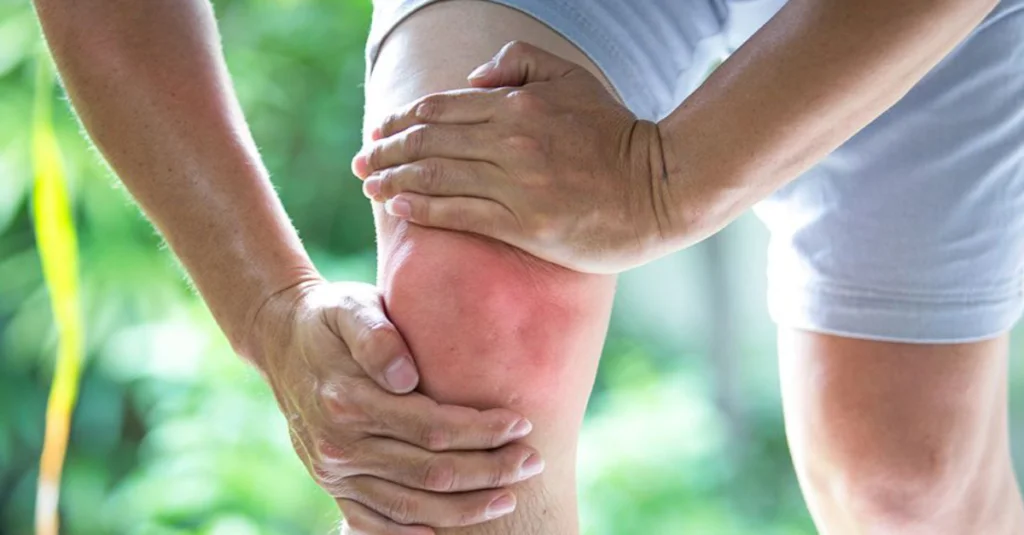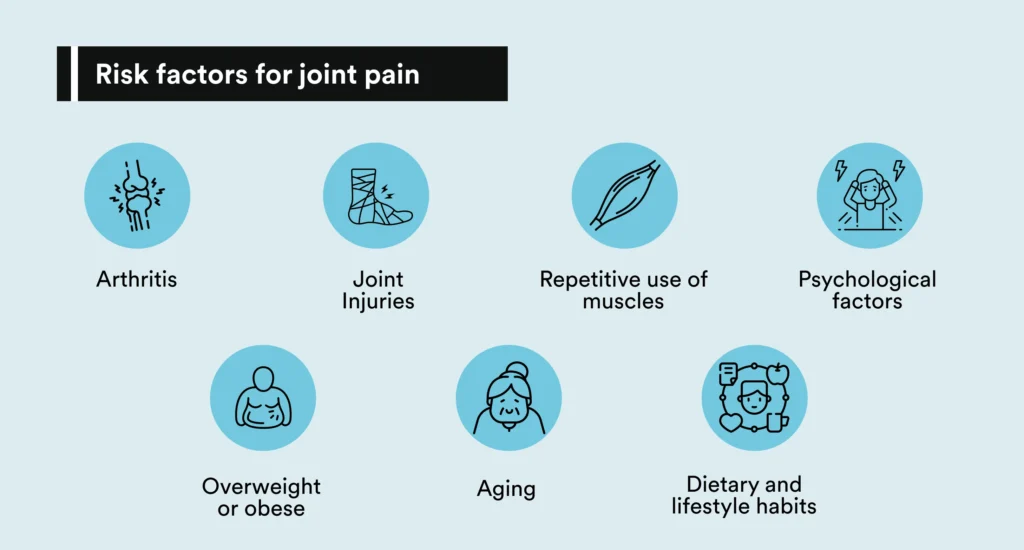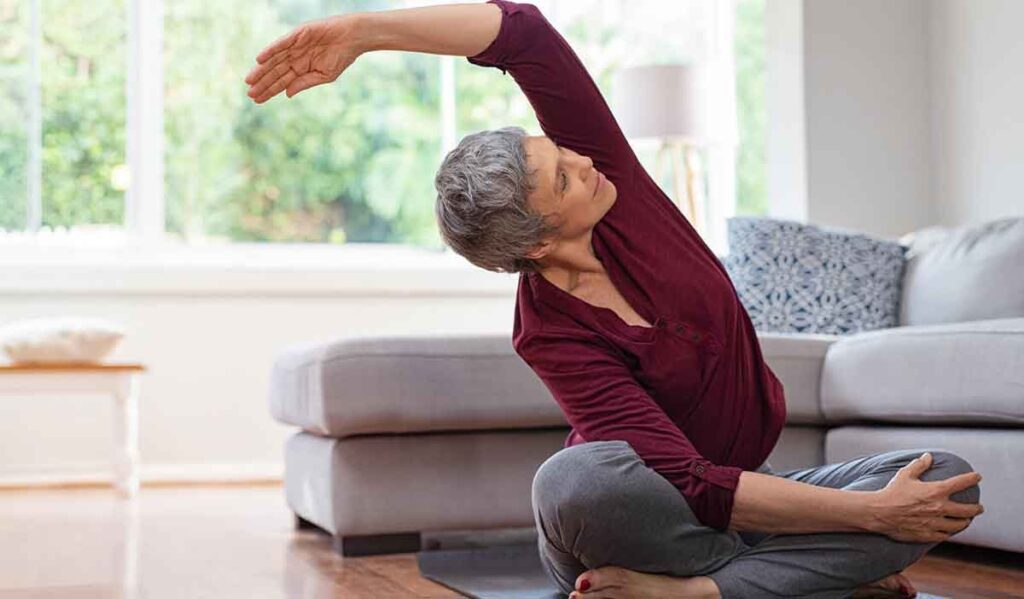
Joint pain affects people of all ages, caused by arthritis, injury, overuse, or inflammation that limits mobility and daily activity. Understanding triggers and maintaining joint health through exercise, weight control, nutrition, and medical care can help relieve pain and prevent long-term damage.
Key Takeaways
- Aging, obesity, and overuse are leading causes of cartilage wear and joint degeneration.
- Balanced nutrition with omega-3s, calcium, vitamin D, and antioxidants supports cartilage and bone strength.
- Low-impact exercises like walking, yoga, and swimming improve flexibility and reduce stiffness.
- Proper hydration, posture, and ergonomics prevent strain and maintain lubrication.
- Early diagnosis and regular check-ups enable timely treatment before irreversible damage.
- Combining lifestyle adjustments with medical guidance ensures long-term joint protection and mobility.
Understanding Joint Health
Joint health refers to the overall condition and proper functioning of the joints, where two or more bones meet to enable movement, provide stability, and absorb physical shock. Healthy joints allow smooth, pain-free motion, flexibility, and support for everyday activities, physical performance, and long-term quality of life.
Joints consist of several key components:
- Cartilage: Covers bone ends, reducing friction and cushioning impacts.
- Synovial Membrane and Fluid: Lubricates the joint and nourishes cartilage to minimize wear.
- Ligaments: Connect bones and provide stability.
- Tendons: Connect muscles to bones, allowing movement.
- Bursa: Fluid-filled sacs that reduce friction between tissues.
Common Risks Affecting Joint Health

Several risks increase the likelihood of joint problems:
- Aging: Natural cartilage wear and reduced synovial fluid occur with age, increasing risk of degenerative joint diseases like osteoarthritis.
- Obesity: Excess body weight puts additional mechanical stress on weight-bearing joints (knees, hips, spine), accelerating cartilage breakdown and increasing pain and dysfunction.
- Joint Injuries: Trauma such as sprains, fractures, or repetitive strain injuries damage joint structures and raise risk for osteoarthritis and chronic joint pain.
- Autoimmune and Inflammatory Conditions: Diseases like rheumatoid arthritis involve immune-mediated joint inflammation, causing pain, swelling, and joint damage.
- Overuse and Repetitive Stress: Activities or occupations that repeatedly stress the same joints can lead to tendonitis, bursitis, or cartilage wear.
- Genetics: Some inherited factors predispose individuals to joint diseases like osteoarthritis or rheumatoid arthritis.
- Poor Nutrition: Deficiencies in key nutrients (e.g., omega-3 fatty acids, calcium, vitamin D, antioxidants) impair cartilage maintenance and increase inflammation.
- Sedentary Lifestyle: Inactivity weakens muscles supporting joints, reducing stability, and contributes to stiffness and pain.
- Other Factors: Smoking, hormonal differences (e.g., women have higher risk for osteoarthritis), and metabolic diseases such as gout also influence joint health.
Ways to Keep Your Joints Healthy
Maintaining healthy joints is essential for staying active and pain-free throughout life. Here are effective ways to protect and support your joints every day.
Regular Exercise

Engaging in low-impact activities such as walking, swimming, cycling, yoga, Pilates, or Tai Chi helps strengthen the muscles surrounding your joints without putting excessive pressure or stress on them. Strong muscles support and stabilize joints, reducing the risk of injury and joint wear. Additionally, exercises improve joint flexibility and range of motion, which help prevent stiffness and maintain smooth movement. Strength training and physical therapy further improve muscle strength and joint stability.
Examples: Walking, swimming, cycling, yoga, tai chi, and light strength training.
Benefits:
- Improves joint flexibility and range of motion.
- Strengthens muscles around joints for better support.
- Reduces stiffness and boosts overall mobility.
- Enhances balance, reducing risk of falls and injuries.
Maintain a Healthy Weight
Carrying excess body weight increases the mechanical load on joints that bear weight, particularly the knees, hips, and spine. This extra stress accelerates cartilage wear, which can lead to joint pain and osteoarthritis. Even losing a small amount of weight reduces the pressure on these joints, slowing cartilage degradation and lowering the risk of joint problems.
Why it matters: Extra body weight puts more stress on your joints especially those that carry weight like knees, hips, and lower back.
Benefits: Reduces risk of osteoarthritis, slows cartilage wear and tear, and eases joint pain.
How to achieve: Aim for gradual weight loss through a balanced diet and regular exercise. Even losing 5-10% of your body weight can significantly reduce joint pressure.
Balanced Nutrition
Eating an anti-inflammatory diet rich in fruits, vegetables, lean proteins, omega-3 fatty acids (found in fatty fish like salmon and plant sources like flaxseeds), calcium, vitamin D, and antioxidants supports joint health. These nutrients nourish cartilage, strengthen bones, reduce inflammation, and help maintain connective tissues. This dietary approach reduces joint pain and may slow the progression of degenerative joint conditions.

Eat an anti-inflammatory diet:
- Prioritize fruits, vegetables, and whole grains.
- Include lean proteins like chicken, turkey, tofu, and legumes.
- Add omega-3 fatty acids from:
- Ensure calcium and vitamin D intake for bone health:
- Antioxidants from berries, dark chocolate, and green tea.
Benefits:
- Nourishes cartilage (the cushioning tissue in joints).
- Strengthens bones.
- Reduces inflammation in joint tissues.
- Maintains connective tissues (ligaments, tendons).
- Can reduce pain and slow down joint degeneration (like in arthritis)
Stay Hydrated
Water is essential for maintaining the lubrication of joints by supporting the production and consistency of synovial fluid, which cushions and nourishes cartilage. Staying well-hydrated prevents joint stiffness and keeps cartilage soft and resilient.
Water is essential for:
- Producing synovial fluid (the lubricating liquid in your joints).
- Keeping cartilage soft and resilient, so it absorbs shocks better.
How to do it:
- Drink water throughout the day, not just when thirsty.
- Monitor urine color (pale yellow means well-hydrated).
Protect Joints From Injury
Using proper techniques during exercise and daily activities prevents unnecessary joint stress and injury. Warming up before physical activity increases blood flow and flexibility, reducing injury risk; cooling down helps muscles relax. Wearing supportive footwear absorbs shock and maintains proper alignment, and protective gear in contact sports helps prevent trauma. Avoiding repetitive strain by varying movements and taking breaks protects joint tissues from overuse damage.
- Use correct techniques during: Exercise (e.g., proper squats, no jerky movements) Lifting objects (lift with legs, not your back)
- Warm up before activity: Gentle stretching, light cardio to increase blood flow.
- Cool down: Helps muscles relax, prevents soreness.
- Wear supportive footwear:Shoes with good cushioning absorb shock, keep joints aligned.
- Protective gear for sports:Helmets, knee/elbow pads in high-risk activities.
- Avoid repetitive strain:Change activities, take breaks, stretch often.
Practice Good Posture and Ergonomics
Maintaining proper posture when sitting, standing, and lifting distributes weight evenly and prevents undue stress on joints, especially the spine and hips. Poor posture can cause joint misalignment and faster wear. Ergonomic adjustments at work or in daily tasks like using chairs that support the back, correct desk height, and proper computer screen positioning reduce repetitive strain injuries.
- Keep proper posture:Sit/stand with shoulders back, spine straight. Use ergonomic chairs and desks; keep feet flat on the floor.
- Lifting:Bend at knees, not waist; keep objects close to body.
- At work/home:Position computer screens at eye level.Use lumbar support in chairs.Take micro-breaks to adjust posture.
- Benefits:evenly distributes weight across joints.Reduces strain, slows joint wear and tear.Prevents musculoskeletal pain (neck, back, hip, knees).
Limit Prolonged Immobility
Sitting or standing in one position for long periods can cause joint stiffness and reduce circulation. Regularly changing positions and stretching keeps joints flexible, helps maintain cartilage health, prevents muscle tightness around joints, and reduces discomfort.
- Avoid staying in one position too long: Sitting or standing for hours leads to stiffness and poor circulation.
- Tips: Stand up, stretch, or walk every 30-60 minutes.Use a standing desk or take short walks during breaks.
- Benefits: Keeps joints flexible and cartilage healthy. Prevents muscle tightness and discomfort.
Regular Medical Check-Ups
Early detection of joint problems through routine medical visits allows timely intervention before irreversible damage occurs. Healthcare providers can identify early signs of arthritis or other joint conditions and recommend lifestyle changes, physical therapy, or treatments to slow progression and relieve symptoms, improving long-term outcomes.
- See your doctor regularly:Even if you feel fine, get routine joint and bone assessments
- Early detection:Arthritis or joint degeneration can be managed better if caught early.Doctors may recommend physical therapy, medication, or lifestyle changes.
- Outcome: Improved long-term joint health, less pain, better mobility.
How to Relieve Joint Pain: Causes, Symptoms, Diagnosis
This table summarizes the most common causes of joint pain, their typical symptoms, distinguishing diagnostic features, and suggested approaches for relief.
| Cause | Common Symptoms | Key Features / Diagnosis | Suggested Relief Approach |
| Osteoarthritis | Stiffness, gradual pain | Age >45, worsens with movement; wear-and-tear; hips, knees, spine; radiographs confirm | Low-impact exercise, weight management |
| Rheumatoid Arthritis | Swelling, morning stiffness | Symmetrical joint pain, worse after rest, multiple joints, blood tests (RF, anti-CCP), physical exam | Anti-inflammatory diet, medical care |
| Gout | Sudden intense pain | Attacks in big toe/foot, uric acid crystals in joint fluid | Limit purine-rich foods, increase hydration |
| Injury / Overuse | Localized swelling, soreness | History of trauma or repetitive activity, acute onset | Rest, ice, gradual return to activity |
| Bursitis | Hot, swollen joint, tenderness | Shoulder, elbow, hip, or knee, follows repetitive motion | Rest, ice, protect joint, gentle exercise |
| Tendinitis | Localized pain, movement worsens | Overuse, repetitive strain, common in elbow, shoulder, knee | Rest, ice, physical therapy, anti-inflammatory meds |
| Autoimmune Diseases | Joint pain + systemic symptoms | Lupus, psoriatic arthritis, Still’s disease, rash, oral ulcers, multi-organ | Medical care, manage systemic symptoms |
| Infection (Septic Arthritis) | Fever, hot/swollen joint | Monoarticular, urgent diagnosis by joint fluid analysis | Immediate medical evaluation |
| Fibromyalgia | Widespread pain, fatigue | Includes joint pain, lacks inflammation | Gentle exercise, stress management |
| Overuse/Exertion | Pain after activity | Temporary, self-limited | Rest, modify activity, gradual return |
Conclusion
Joint pain can result from arthritis, injury, overuse, or inflammation, affecting daily activities and mobility. Managing it effectively requires a multi-step approach. First, protect joints by pacing activities, avoiding static positions, and using supportive devices. Maintain a healthy weight to reduce pressure, follow an anti-inflammatory diet rich in fruits, vegetables, whole grains, fatty fish, and olive oil, and stay hydrated. Engage in low-impact exercises like swimming, walking, yoga, and tai chi to strengthen muscles and improve flexibility. Use heat for stiffness, cold for swelling, and consider topical agents like capsaicin. Mind-body techniques such as CBT, mindfulness, and relaxation help reduce pain perception.
Home remedies like cabbage leaf compresses, ergonomic adjustments, and gentle stretching offer additional relief. When self-care isn’t enough, medical options include NSAIDs, corticosteroid or hyaluronic acid injections, and surgery. Combining lifestyle changes, exercise, and timely medical care can significantly improve comfort and joint function.
FAQs
What exercises are safe for aging joints?
Walking, swimming, cycling, yoga, and Pilates are gentle and joint-friendly.
How often should I take movement breaks when working at a desk?
Every 20 to 30 minutes, stand up and stretch or move for at least one minute.
Which foods reduce joint inflammation?
Fish high in omega-3s, nuts, leafy greens, berries, and spices like turmeric and ginger.
Are joint supplements effective?
Some, like glucosamine, chondroitin, and turmeric, may help, but results vary and should be discussed with a doctor.
How much weight loss helps joint health?
Losing even 5 to 10 percent of your body weight can significantly reduce joint stress.
What footwear best supports joint health?
Shoes with cushioning, support, and a proper fit; avoid high heels and worn-out shoes.
When should I see a doctor about joint pain?
If pain lasts more than a week, affects your daily activities, or comes with swelling or redness.
Are high-impact exercises harmful to knees and hips?
For some people, yes. It is best to mix in low-impact options and listen to your body.
Can hydration reduce joint stiffness?
Yes, staying hydrated keeps joint fluid levels healthy and may reduce stiffness.
Is it possible to prevent osteoarthritis?
While not all cases can be prevented, staying active, maintaining a healthy weight, and protecting your joints greatly lower the risk.
Reference
- Felson, D. T. et al. (1995). Risk factors for knee osteoarthritis in the elderly. Arthritis & Rheumatism, 38(10), 1500–1505. https://doi.org/10.1002/art.1780381020
- Nelson, M. E. et al. (2007). Physical activity recommendations for older adults. Med Sci Sports Exerc, 39(8), 1435–1445. https://doi.org/10.1249/mss.0b013e3180616aa2
- Calder, P. C. (2006). Omega-3s and inflammation. Am J Clin Nutr, 83(6), 1505S–1519S. https://doi.org/10.1093/ajcn/83.6.1505S
- Popkin, B. M. et al. (2010). Water, hydration, and health. Nutr Rev, 68(8), 439–458. https://doi.org/10.1111/j.1753-4887.2010.00304.x
- Jämsen, E. et al. (2011). Lifestyle risk factors for joint infection. Acta Orthop, 82(4), 491–497. https://doi.org/10.3109/17453674.2011.588861
Dr. Carlos Mendoza, MD, PhD, is a rheumatologist and clinical researcher with 15 years of experience in musculoskeletal health, joint preservation, and inflammation management. He earned his PhD in Immunology from University of Toronto and completed his medical residency at Mayo Clinic. Dr. Mendoza’s practice bridges traditional rheumatology with emerging nutraceutical and anti-inflammatory interventions. He has published extensively on cartilage repair and omega-3 supplementation for joint function.

